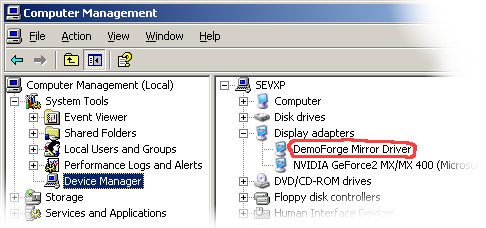


- #DEMOFORGE MIRAGE DRIVER FOR TIGHTVNC SOFTWARE#
- #DEMOFORGE MIRAGE DRIVER FOR TIGHTVNC CODE#
- #DEMOFORGE MIRAGE DRIVER FOR TIGHTVNC FREE#
And it uses something called the RDP protocol. That's quite brilliant, because it can just send simple text (draw this rectangle at this coordinate and color it with this gradient)! Remote Desktop really is pretty fast - and it's the standard way of working from home. I heard, from somewhere on StackOverflow, that Windows Remote Desktop doesn't send screen bitmaps, but actual drawing commands. Microsoft Windows Remote Desktop apparently goes one step higher than VNC. And they use something called the RFB protocol. At their best, they use a mirror driver like DFMirage. VNCs use poll-based hooks for detecting screen change and brute force screen capturing/comparing at their worst. Think about how robust TeamViewer's screen-transfer solution must be to accomplish all this.
#DEMOFORGE MIRAGE DRIVER FOR TIGHTVNC CODE#
Scrolling code vertically in Visual Studio has 50 ms lag time. I can browse the web just a few milliseconds slower than on my laptop. I ran a tree command on Command Prompt and it updated with 20 ms delay.

Not quite sure about CrossLoop, LogMeIn - I haven't used them, but TeamViewer is insanely fast.
#DEMOFORGE MIRAGE DRIVER FOR TIGHTVNC SOFTWARE#
It's just as slow as VNC (btw, I don't use the VNC protocol, just a custom amateur protocol).įrom the slowest remote desktop software to the fastest, the list usually begins at all VNC-like implementations, then climbs up to Microsoft Windows Remote Desktop.and then.TeamViewer. Things are looking pretty good, but it's not fast enough. Then I compress the screen region as a PNG and send it off from the server to my client. Regarding screen transfer/sharing, thanks to the mirror driver, I'm automatically notified of changed screen regions and I can simply marshal the mirror driver's ever-changing screen bitmap to my own bitmap.
#DEMOFORGE MIRAGE DRIVER FOR TIGHTVNC FREE#
I've gotten through basic obstacles: I have a robust UDP messaging system, relatively clean program design, I've got a mirror driver (the free DFMirage mirror driver from DemoForge) up and running, and I've implemented NAT traversal for all NAT types except Symmetric NATs (present in corporate firewall situations). I'm developing a remote desktop software (just for fun) in C# 4.0 for Windows Vista/7. What makes video mirroring more efficient than basic screen grabbing is that the former only focuses on areas of the screen that get updated and fetches the data directly, while the latter retrieves a lot of unnecessary data and transfers it without bypassing the intermediate copy.ĭemoForge Mirage Driver for TightVNC helps users retrieve data efficiently through video mirroring and also detect the areas on the screen that have been modified, keeping data consumption to a minimum.ĭeploying the driver to the target computer should pose no difficulty even for novices, since it's based on plug-and-play technology, which instantly adds it to the device manager without requiring the computer to be rebooted beforehand.Sorry about the length, it's kinda necessary. The display mirroring technology is generally used by various remote desktop software solutions such as VNC, TeamViewer, TightVNC and many others. The driver was designed for virtual video devices that are handled at a DDML level and can help users mirror the drawing operations of several devices at the same time in an accurate manner. DemoForge Mirage Driver for TightVNC is, as its name suggests, a driver that was developed for TightVNC users that would like to use cutting-edge technology while performing video mirroring.


 0 kommentar(er)
0 kommentar(er)
